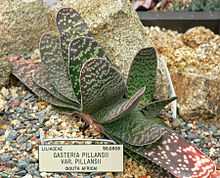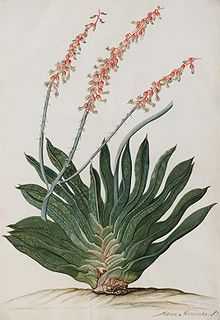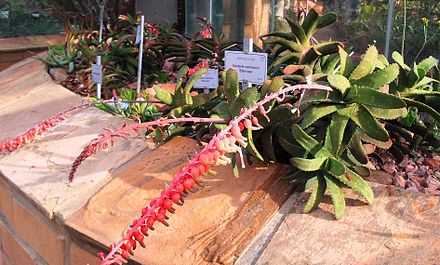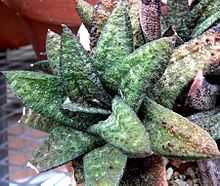Gasteria
| Gasteria | |
|---|---|
 | |
| Gasteria_pillansii | |
| Scientific classification | |
| Kingdom: | Plantae |
| Clade: | Angiosperms |
| Clade: | Monocots |
| Order: | Asparagales |
| Family: | Xanthorrhoeaceae |
| Subfamily: | Asphodeloideae |
| Genus: | Gasteria Duval |
| Synonyms[1] | |
|
Ptyas Salisb. | |

Gasteria is a genus of succulent plants, native to South Africa (and the far south-west corner of Namibia).[1]
Naming
The genus is named for its stomach-shaped flowers ("gaster" is Latin for "stomach"). Common names include ox-tongue, cow-tongue, lawyer's tongue and, occasionally, mother-in-law's tongue.[2]
Description
Gasterias are recognisable from their thick, hard, succulent "tongue-shaped" leaves. Their inflorescence is also unique, with their curved, stomach-shaped flowers, which hang from inclined racemes.
Distribution


The species of this genus are mostly native to the Eastern Cape Province, South Africa, where the bulk of the species occur - especially in the small area between Grahamstown and Uniondale which enjoys rainfall throughout the year. However distribution of several species extends widely across the low-altitude coastal regions of the country, in an arched horseshoe shape across South Africa. At the one end of the genus's distribution, a species Gasteria pillansii extends into the far south-west corner of Namibia. At the other end, a species reaches the Lebombo mountains of Swaziland.
Taxonomy
Gasteria is part of the family Xanthorrhoeaceae, subfamily Asphodeloideae. Closely related genera include Aloe and Haworthia, and the species of these genera are known to hybridise relatively easily with each other.[3]
Using morphology (especially flower structure), the genus has traditionally been divided into two sections, four series, and 23 species.
- Section Gasteria (2 series, 9 species)
- Series Gasteria (8 species):
- Gasteria baylissiana Rauh - Suurberg Range in Cape Province
- Gasteria bicolor / Gasteria obliqua (vars. bicolor, fallax, liliputana)(Aiton) Duval - Cape Province; naturalized in Mexico
- Gasteria brachyphylla (vars. brachyphylla, bayeri)(Salm-Dyck) van Jaarsv. - Little Karoo in Cape Province
- Gasteria disticha (vars. disticha, langebergensis, robusta)(L.) Haw. - Cape Province
- Gasteria dorineae van Jaarsv. & A.E.van Wyk - Cape Province
- Gasteria glomerata van Jaarsv. - Konga Dam in Cape Province
- Gasteria rawlinsonii Oberm. - Baviaanskloof in Cape Province
- Series Namaquana (1 species):
- Gasteria pillansii (vars. pillansii, ernesti-ruschii, hallii)Kensit - Namibia, Cape Province
- Series Gasteria (8 species):
- Section Longiflorae (2 series, 14 species)
- Series Longifoliae (4 species):
- Gasteria acinacifolia (J.Jacq.) Haw. - Cape Province
- Gasteria batesiana (vars. batesiana, dolomitica)G.D.Rowley - Northern Province, Mpumalanga, KwaZulu-Natal
- Gasteria croucheri (subsps. croucheri, pendulifolia, pondoensis)(Hook.f.) Baker - Cape Province, KwaZulu-Natal
- Gasteria tukhelensis van Jaarsv. - KwaZulu-Natal
- Series Multifariae (10 species):
- Gasteria carinata / Gasteria retusa (vars. carinata, glabra, verrucosa)(Mill.) Duval - Cape Province
- Gasteria ellaphieae van Jaarsv. - Konga Dam in Cape Province
- Gasteria excelsa Baker - Cape Province
- Gasteria glauca van Jaarsv - Cape Province
- Gasteria armstrongii / Gasteria nitida (Salm-Dyck) Haw. - Cape Province
- Gasteria polita van Jaarsv. - Cape Province
- Gasteria pulchra (Aiton) Haw. - Cape Province
- Gasteria thunbergii
- Gasteria vlokii van Jaarsv. - Great Swartberg + Witteberg in Cape Province (a higher altitude species)
- Series Longifoliae (4 species):
Recent phylogenetic studies[4] suggest that the genus is actually sub-divided into:
- 5 coastal species
- 13 inland species (5 widespread, 8 rare and restricted)
- Gasteria batesiana (a species from the far north)
- Gasteria rawlinsonii (genetically an outlier)
Cultivation
Gasteria species are grown in well-drained, sandy soils in light shade. The species can all be propagated by off-sets and cuttings (leaf cuttings can usually be rooted easily). They are also commonly propagated by seed. Germination usually occurs within 8 days but may take as long as one month depending on the species.[5][6]
Several hybrids with species in other related genera have been created in cultivation, such as between Gasteria and Aloe (×Gasteraloe), and between Gasteria and Haworthia (×Gasterhaworthia).
External links
| Wikimedia Commons has media related to Gasteria. |
References
- ↑ 1.0 1.1 Kew World Checklist of Selected Plant Families
- ↑ Bailey, L.H.; Bailey, E.Z.; the staff of the Liberty Hyde Bailey Hortorium. 1976. Hortus third: A concise dictionary of plants cultivated in the United States and Canada. Macmillan, New York.
- ↑ Stevens, P.F., Angiosperm Phylogeny Website: Asparagales: Asphodeloideae
- ↑ B. J. M. Zonneveld, E. J. van Jaarsveld: Taxonomic implications of genome size for all species of the genus Gasteria Duval (Aloaceae). 24 Feb 2005
- ↑ Propagation of Gasterias - article
- ↑ Gasteria